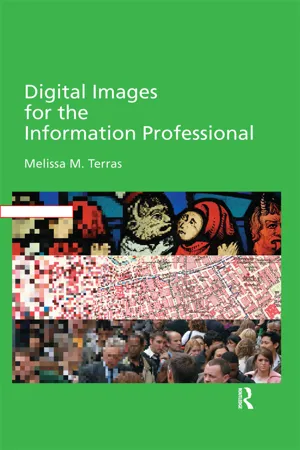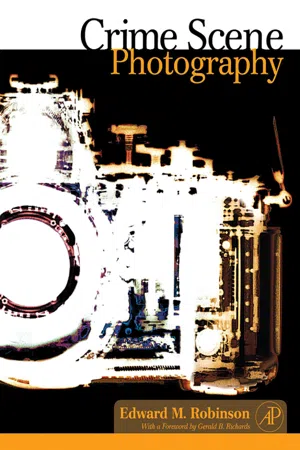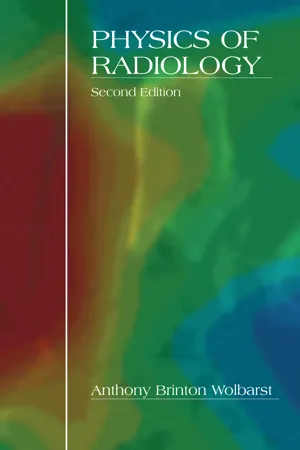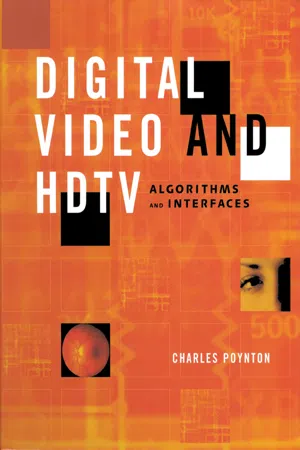Computer Science
Bit Depth
Bit depth refers to the number of bits used to represent the color of each pixel in an image or the amplitude of audio samples. In digital imaging and audio, higher bit depth allows for a greater range of colors or sound levels to be represented, resulting in higher quality and more accurate reproduction of the original data.
Written by Perlego with AI-assistance
Related key terms
1 of 5
6 Key excerpts on "Bit Depth"
- eBook - ePub
- Melissa Terras, Melissa M. Terras(Authors)
- 2016(Publication Date)
- Routledge(Publisher)
It should also be noted, though, that digital sensors treat colour differently from analogue film (see pp. 185–191) and so differences will be present in how colour will be represented between a digital and traditional print image of the same object or scene. As a result, the question of when digital photography will replace film should be tempered by the notion that the two technologies function in different manners – and although one can be an alternative to the other, they each bring various characteristics to the medium which cannot be replicated or replaced.Bit Depth
The term Bit Depth, or colour depth, refers to the number of bits which are used to represent the colour of each individual pixel within a bitmapped graphic. The amount of colour information stored for each pixel is dependent on the number of bits available: the greater the number of bits assigned to each pixel (for example 1, 4, 8, 16, 24, 32 or 48) the greater the number of colours and tones the image can contain, and the display can attempt to reproduce. However, the more colour information captured and stored, the higher the resulting file size. The play-off between storage and dissemination costs, usability and usefulness means choices have to be made regarding the optimum Bit Depth to capture and store an image.1-Bit Bitonal
The simplest, and least computationally expensive Bit Depth, is 1-bit. An individual bit can be in two states, 0 or 1, and so there can only be two colours in a 1-bit image: 21 = 2. The colour of each individual pixel can be described as 0 or 1: black or white. This simple colour representation is often referred to as a binary tone, or bitonal, image.Early computer graphics displays, until the early 1980s, were only capable of displaying one colour against the screen’s background, and these monochrome, or bitonal, representations would generally glow green or amber against the screen’s background. However, since graphics technology has improved, the use of bitonal images has become limited, as the black-or-white nature of the image limits the range of tone and detail it can represent. It may be suitable, in some cases, to capture clearly printed text in a 1-bit bitonal image, but the current archival recommendation is that black and white material be captured in greyscale to ensure that the tonal-range of the original is represented (Library of Congress 2007). - eBook - PDF
- Edward M. Robinson(Author)
- 2010(Publication Date)
- Academic Press(Publisher)
Bit Supporting equation Possible combinations of 1 or 0 2 1 2 x 1 2 2 2 2 x 2 4 2 3 2 x 2 x 2 8 2 4 2 x 2 x 2 x 2 16 2 5 2 x 2 x 2 x 2 x 2 32 2 6 2 x 2 x 2 x 2 x 2 x 2 64 2 7 2 x 2 x 2 x 2 x 2 x 2 x 2 128 2 8 2 x 2 x 2 x 2 x 2 x 2 x 2 x 2 256 Figure 8.9 This table illustrates how each additional bit doubles the possible number of combinations of 1 or 0, which is expressed in powers of 2. Therefore, 2 8 would provide 256 possible combinations . . . or tonal values. The contrast between 4-, 8-, and 16-bit color depth is rather astonishing. The additional contrast provides more detail within the image. Now that we know 8 bits allow us to display 256 shades of gray, let us see whether we can add to the complexity of terms without confusion. Many people refer to 8-bit color and 24-bit color as the same thing. Although 8-bit color is typically used to describe the gradient tonal range from black to white, it is also used to describe 24-bit color, because there are 8 bits or 256 tonal values for each color channel—red, green, and blue. Earlier we said that 8 bits equal 1 byte. Therefore, each picture element (also known as a pixel) has 1 byte for each color: red, green, and blue. Each byte allows us to represent up to 256 shades. Similarly, as shown in Figure 8.11, 16-bit and 48-bit color are often used interchangably to describe tonal value in digital images. Regardless of whether your digital camera uses a CCD (charge-coupled device) or a CMOS (complimentary metal-oxide semiconductor) imaging sensor, the sensor starts at the same point. It has to convert light into an electronic signal that is broken down into a digital value for each sensor, which is also commonly referred to as a pixel. During this process, the computer assigns a red, green, and blue color value for each pixel. This means that there are 3 bytes for each pixel. This means that if you have a 6 million pixel (aka, megapixel) camera, your noncompressed image size would be 18 million bytes. - eBook - ePub
- Lee Lanier(Author)
- 2012(Publication Date)
- Routledge(Publisher)
CHAPTER 3Bit Depths, Color Spaces, and Color GradingA critical component of digital compositing is the proper selection and conversion of color spaces. Failure to take color space into account can lead to composites with mismatched color values or color artifacts. In addition, image formats vary in their fundamental mathematical makeup, leading to additional concerns as files are imported into Nuke and written out to disk. Once the technical aspects of color space and image format conversion are mastered, aesthetic color adjustments remain. Such adjustments fall under the auspice of color grading. Nuke offers a wide range of color filter nodes that allow you to undertake color grading within the program.This chapter includes the following critical information: • Understanding Bit Depth, color space, and look-up tables • Converting between color spaces in Nuke • Differentiating among linear, logarithmic, integer, and floating-point image formats • Color grading with Nuke color filter nodesUnderstanding Bit Depth
Digital images carry three channels: red, green, and blue (RGB). (Other specialized channels, such as alpha, are carried by a limited number of file formats and are discussed throughout this book.) Each channel’s Bit Depth establishes how many potential colors (or tonal steps) that channel can carry. Bit Depths are expressed as a number, such as 1-bit, 2-bit, and so on. The number represents an exponent where the base is 2. For example, 1-bit equates to 21 or simply 2. 8-bit equates to 28 or 256; hence, an 8-bit image has 256 potential colors per channel for a total of 16,777,216 potential colors (28 × 28 × 28 ). The number 2 is used as the base because a single bit has two potential states (0/1 or off/on). A bit - eBook - PDF
- Anthony Wolbarst(Author)
- 2005(Publication Date)
- Medical Physics Publishing(Publisher)
[Courtesy of W.S. Kiger, III, Massachusetts Institute of Technology.] a b c d number of gray scale levels can give rise to artifacts, such as the false appearance of sharp edges. The number of bits required to represent image intensity at each pixel depends on the number of gray levels that the system is designed to accommodate. Because every picture element in Figure 22-4a is to display 256 levels of gray (requiring an 8-bit deep value system), the image is fully described in a listing of a quarter-million bytes, one for each address. For greater con- trast resolution or dynamic range, more than one byte (e.g., 10 bits) would be used as the pixel value at each address. 4. Making the Image More Meaningful to the Eye: Windowing and Filtering The three basic measures of radiograph image quality, namely resolution, contrast, and noise level, are also relevant for digital images, and we can couch some of these ideas in computer- friendly language. Regardless of how a digital image is produced, its infor- mation content depends on the fineness of its spatial detail, on the subtlety of the variations in shadings of gray or color that can be distinguished, and on the level of visual noise. The smaller the pixels (and the greater their number), the more gray levels of shading, and the quieter the random fluctuations, the more faithfully a digital representation can capture and repro- duce clinical reality. At the same time, the computer time and power required to process, ship, and store an image—hence the cost—rise correspondingly. The appearance (and the diagnostic worth) of an image can be improved only so much, with smaller pixels and more gray levels, before the law of diminishing returns sets in. Beyond that, the physician’s eye will not be aware of (nor will 22. DIGITAL REPRESENTATION OF AN IMAGE 259 patients profit from) additional enhancements in spatial resolution or contrast, and further efforts and dollars are largely wasted. - eBook - PDF
Optical Imaging and Photography
Introduction to Science and Technology of Optics, Sensors and Systems
- Ulrich Teubner, Hans Josef Brückner(Authors)
- 2019(Publication Date)
- De Gruyter(Publisher)
As a consequence, statements that a larger Bit Depth of an ADC leads to a better reproduction of subtle tonalities from a scenery becomes wrong when the decrease in step size (due to an increase in Bit Depth) is surpassed by noise. For instance, there are a lot of professional DSLRs equipped with 14-bit sensors, but due to the noise limit, the real Bit Depth i.e., DS max is much below, e.g., 11 bits only. These DSLRs still may be of high-quality, but they are far beyond the stated specified depth resolution or DS which of course, is easily justified by measurements. Consequently one should be aware of wrong statements on Bit Depth resolution. A 14-bit ADC, of course, has a larger Bit Depth and thus can discriminate more shades in principle, but this does not necessarily provide a better tonal reproduction of the analogous signal at all when compared to a 11-bit one. The only advantage of larger Bit Depth, i.e., an ADC with more channels, is that the image may contain more tonal grades and thus it may look smoother. This advantage may be important to avoid posterization and banding. These kind of artefacts result when, e.g., the object has a surface with a smooth continuous gradation of the colors. If this cannot be reproduced smoothly as well, at some positions the right “transition color” or its corresponding lightness or brightness between neighbored ones is missing (see, e.g., the example in Figure A.10). This results in clearly seen step-like color bands. At this point, the per-ceived image quality depends more on smoothness than on a correct reproduction of the colors within the gradient across the surface. Note that posterization and banding may also result from poor quality image postprocessing or poor data compression. In particular, when the image is processed within an 8-Bit Depth instead of, e.g., a 32-bit floating point space, subsequent rounding may result in missing tonal values, which often becomes apparent. - eBook - PDF
Digital Video and HD
Algorithms and Interfaces
- Charles Poynton(Author)
- 2003(Publication Date)
- Morgan Kaufmann(Publisher)
Figure 4.6 sketches the three usual modes available in a system having one megabyte (1 MB) of VRAM. The top sketch illustrates truecolor (24 bits per pixel) operation. With just 1 MB of VRAM the pixel count will be limited to 1/3 megapixel, 640x480 (VGA). The advantage is that this mode gives access to millions of colors simultaneously. To increase pixel count to half a megapixel with just 1 MB of VRAM, the number of bits per pixel must be reduced from 24. The middle sketch shows hicolor (16 bit per pixel) mode, which increases the pixel count to 1/2 megapixel, 800x600. However, the display is now limited to just 65536 colors at any instant. To obtain a one-megapixel display, say 1152x864, pixel depth is limited by 1 MB of VRAM to just 8 bits. This forces the use of pseudocolor mode, and limits the number of possible colors at any instant to just 256. 40 DIGITAL VIDEO AND HDTVALGORITHMS AND INTERFACES Image width is the product of so- called resolution and the count of image columns; height is computed similarly from the count of image rows. A point is a unit of distance equal to 1/72 inch. The width of the stem of this bold letter I is one point, about 0.353 mm (that is, 353 pro). In addition to constraining the relationship between pixel count and pixel depth, a display system may constrain the maximum pixel rate. A pixel rate constraint- 100 megapixels per second, for example- may limit the refresh rate at high pixel counts. A computer specialist might refer to display pixel count, such as 640x480, 800x600, or 1152x864, as resolu- tionS' An image scientist gives resolution a much more specific meaning; see Resolution, on page 65. Image files Images in bilevel, grayscale, pseudocolor, or truecolor formats can be stored in files. A general-purpose image file format stores, in its header information, the count of columns and rows of pixels in the image. Many file formats - such as TIFF and EPS - store infor- mation about the intended size of the image.
Index pages curate the most relevant extracts from our library of academic textbooks. They’ve been created using an in-house natural language model (NLM), each adding context and meaning to key research topics.





